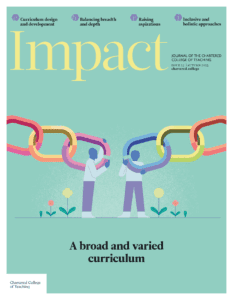It’s hard to be what you cannot see: Subjectification and inclusion within the languages curriculum

KAREN HANRAHAN, IOE, UCL’S FACULTY OF EDUCATION AND SOCIETY, UK
HANNAH VENTISEI, CLAPTON GIRLS’ ACADEMY, UK
Biesta (2015) argues that education serves three overlapping purposes: qualification (developing knowledge and skills), socialisation (becoming part of existing social and cultural norms and traditions) and subjectification (developing students’ agency or ‘subject-ness’). In advocating for a ‘flipped curriculum’ – which places subjectification at the heart of education, with qualification and socialisation playing supporting roles – Biesta (2022) contends that education ultimately involves learning ‘what it means to exist in and with the world in a grown-up way’ (p. 51).
In this article, we consider the extent to which the current languages curriculum supports this ‘flipped’ view of education, enabling students to explore the world and their place within it alongside acquiring important linguistic knowledge and cultural understanding. How can the aims of qualification and socialisation be balanced alongside opportunities for identity negotiation and meaning-making? How can languages teachers and students co-construct the curriculum, shaping it to suit the unique context of their classroom? Drawing on our experiences as a teacher educator and an early career teacher (ECT), we explore both the need and the scope for creative interpretations of the curriculum to celebrate the complexity of students’ identities, develop their intercultural communication and foster a sense of inclusionAn approach where a school aims to ensure that all children are educated together, with support for those who require it to access the full curriculum and contribute to and participate in all aspects of school life and belonging.
Qualification
The first of the three dimensions, qualification, tends to command much of the focus in language lessons. Qualifications in languages in England are centred around GCSE and A-levels, with a lack of vocational qualifications to support alternative pathways (Collen et al., 2023). An overemphasis on high-stakes assessment eclipses the cultural, social and personal dimensions of language learning. Recent GCSE reforms introduced from September 2024 have been shaped by the modern foreign languages pedagogy review (Teaching Schools Council, 2016) and by what OfstedThe Office for Standards in Education, Children’s Services and Skills – a non-ministerial department responsible for inspecting and regulating services that care for children and young people, and services providing education and skills (2021) refers to as the ‘three pillars’ approach (encompassing phonics, vocabulary and grammar). Secondary language policy therefore echoes prevailing instrumental approaches to the curriculum (Sehgal Cuthbert and Standish, 2021) and risks perpetuating inequality by making progression to university more challenging and less inclusive (Cazzoli, 2022). It also undermines teacher agency by constraining opportunities for teachers to exercise professional judgement and adapt their pedagogy to their local context (Pachler and Broady, 2022). Such mechanical approaches to language learning do little to alleviate the ongoing ‘crisis’ in languages, a well-documented picture of declining uptake throughout the education pipeline, with significant implications for teacher recruitment and retention. When combined with low student motivation and self-efficacy (Lanvers and Graham, 2022), this suggests that, for many learners, the relevance of languages as a curriculum subject does not translate.
Socialisation
This brings us to the next aim of education: socialisation. To what extent does the languages curriculum in England challenge or perpetuate existing views of the subject as elitist, gendered, difficult and predominantly functional? Research suggests that too many students do not see themselves represented in the current framework and how it is enacted within schools. Lanvers (2017) suggests that the social divide in language learning is now ‘unrivalled’ when compared with any other subject. For example, the biggest difference in take-up of languages is between selective state-funded schools (90 per cent of students) and non-selective (48 per cent). Boys from poorer backgrounds attending state schools with high levels of free school meals are the least likely to take languages at GCSE or beyond (Lanvers, 2017). Decoupling language from culture and presuming monolingualism as the default overlooks research on student motivation as well as the reality – and relevance – of students’ rich and diverse cultural and linguistic identities. Around 21.4 per cent of students across England speak English as an additional language (DfEDepartment for Education - a ministerial department responsible for children’s services and education in England, 2025c). The Curriculum and Assessment Review’s interim report (DfE, 2025a) emphasises the importance of cultural knowledge and skills in addressing global social and environmental challenges; languages, as a subject area, is uniquely placed to respond to this need. All students come to language lessons saturated with linguistic and cultural experiences. Neglecting students’ existing linguistic repertoires and their lived realities in the pursuit of a monolithic vision of language learning, implicit in the current ‘three pillars’ approach, can reinforce anglonormative perspectives and lead to feelings of marginalisation. While visibility and support for home, heritage and community languages is growing (Collen and Duff, 2024), there is a need for languages pedagogy to be culturally relevant in order to challenge barriers to inclusion and progression.
Subjectification
The third, and often neglected, function of education identified by Biesta – subjectification – refers to the development of agency and the capacity to think critically and independently. As languages teachers, we understand how communicating in other languages and engaging interculturally enable us to experience ourselves – and the world – differently. Language is not merely a linguistic system, nor is it a neutral medium of communication. Language is a social practice, through which we organise our experiences and negotiate our identities (Norton, 2010). A broad and balanced curriculum therefore means attending to the social as well as the technical aspects of language. Acknowledging and nurturing students’ sense of agency and the complex, shifting identities that they bring to the languages classroom is key to fostering a sense of connection and engagement. This means recognising students’ linguistic and cultural backgrounds but also how other factors, such as race, gender, religion, socioeconomic disadvantage, neurodivergence, disability and sexual orientation, intersect to shape their experiences and sense of belonging.
Ostensibly, this philosophy does not deviate from the overarching rationale of the current curriculum. The subject aims for French, German and Spanish at GCSE state that languages should ‘build students’ confidence and broaden their horizons, enabling them to step beyond familiar cultural boundaries [and] develop new ways of seeing the world’ (DfE, 2025b, p. 3). This builds on the National Curriculum for Key Stages 2 and 3, where languages are described as ‘a liberation from insularity’ (DfE, 2013). However, although promoted by the Common European Framework of Reference for Languages (CEFR) (Council of Europe, 2020) and integrated into the Welsh languages curriculum (Duff et al., 2024), references to plurilingualism are notably absent from current policy discourse in England.
Teachers and students as curriculum-makers: An initial teacher trainingAbbreviated to ITT, the period of academic study and time in school leading to Qualified Teacher Status (QTS) perspective
Working with PGCE and MA students, I (Karen) facilitate workshops in which students are invited to explore their own language learning autobiographies. They can represent the unique story of how their lives have been shaped by language and culture in any form that they wish. Over the years, students have communicated their narratives in many creative, multimodal ways: through food, music, role-play with their younger selves and various visual media (drawings, collage, photos), as well as through a variety of written forms (reflective writing, letters, poetry, cultural myths and fairytales, layered texts). Cryptic artefacts have emerged from ‘feely bags’, which we have been tasked to make sense of using clues.
The following extract is from a student’s language autobiography, written during a recent workshop. Blending reflections, poetry and course readings, she produced a layered text that explores her multilingual and intercultural identities, while also exemplifying her communicative and linguistic competence:
“My linguistic identity is intercultural par excellence, yet the Arabic language takes the lion’s share of my linguistic repertoire… It walks hand in hand with every language I use… My thoughts in Arabic manifest every time I speak French, English, or Turkish – a language I am still learning. Even though I am not writing in Arabic, I am writing about Arabic. This is perhaps, as Richardson (2001) argues “what you write about and how you write it shapes your life”. Perhaps because –
Arabic is kind and giving
Never fails the wanderer in the oasis of words.
Fresh and tender,
As generous as
The dangling bunches of ripe dates.
Perhaps because –
It has athletic letters
Dancing gracefully
On the walls of ancient arcades,
Reminiscent of the glorious past.
Or perhaps because –
It’s mystic and poetic
Too good to be –
A midsummer night’s dream.”
by Abir Moussaoui
By placing the workshop towards the beginning of the academic year, I find that this reflexive practice fast-tracks the relationship-building phase of the group, creating a powerful space for learning about and from each other. Reflecting on their “languaged” lives (Ellis, 2018) sensitises student teachers to how their own plurilingual repertoires influence their teacher self and highlights the importance of creating opportunities for identity work within their own classrooms. We consider how integrating intercultural perspectives – beyond Eurocentric conceptualisations – alongside language can contribute to a decolonised and more diverse curriculum.
Intercultural explorations: An ECT perspective
Recently, my (Hannah’s) Year 9 French group presented celebrations of their choice. This was a particularly valuable exercise because students could represent their own lived experiences and traditions but through the lens of how to communicate different parts of their own identity in French to their peers, their teachers and also themselves.
One drawback of student-led presentations is the time required for students to conceive of, make and present the work. However, it is also possible to create moments for students to express themselves within the production task at the end of a lesson. For instance, with this same Year 9 group, I ended a lesson about food with a production activity, in which students created their own menu in French. After explaining the instructions, a student asked, ‘Does it have to be a French restaurant, or can it be somewhere with food I would actually eat?’ This question in itself implies a perception of French as other, and perhaps as unrelatable to her own tastes and interests. As a teacher, this made me reflect on the narrow version of French culture that I had been teaching this class when I showed pictures of pâtisseries in Paris and menus featuring snails, crêpes and other dishes particular to France. This student made a menu of halal sandwiches, so her separation between ‘French food’ and the food on her menu suggests that she did not know the extent of diverse cuisine in the Francophone world. This demonstrates the importance of showing authentic examples from a variety of Francophone cultures as a teacher, so that students can change their mindset from ‘self versus other’ to one that relates to similarities and appreciates differences between cultures.
Conclusion
These practical examples aim to show how the languages classroom offers a unique space for self-making and world-making (Bruner, 2001), broadening horizons and reducing the distance between self and other. This is consistent with Biesta’s notion of subjectification. Attending to identity work fosters a more inclusive, plurilingual and intercultural classroom environment, where the ‘three pillars’ of phonics, vocabulary and grammar also play an important role. Such an approach also supports the other functions of education: qualification and socialisation. Framing students as curriculum-makers can further reinforce their sense of agency, helping to ensure that students see languages as a subject worth investing in and in which they see themselves represented, both within and beyond the classroom.
- Biesta G (2015) What is education for? On good education, teacher judgement, and educational professionalism. European Journal of Education 50(1): 75–87.
- Biesta G (2022) World-Centred Education: A View for the Present. New York: Routledge.
- Bruner JS (2001) Self-making and world-making. In: Brockmeier J and Carbaugh D (eds) Narrative and Identity. The Netherlands: John Benjamins Publishing Company, pp. 25–37.
- Cazzoli MA (2022) Can the gap get any wider? How the new GCSE curriculum will make progression to university more challenging and less inclusive. Language Learning Journal 50(2): 268–272.
- Collen I and Duff J (2024) Language Trends England 2024. British Council. Available at: www.britishcouncil.org/research-insight/language-trends-england-2024 (accessed 25 July 2025).
- Collen I, Henderson L, Liu M et al. (2023) Languages provision in UK further education. The British Academy. Available at: www.thebritishacademy.ac.uk/publications/languages-provision-in-uk-further-education (accessed 16 April 2025).
- Council of Europe (2020) Common European Framework of Reference for Languages: Learning, teaching, assessment. Available at: www.coe.int/lang-cefr (accessed 16 April 2025).
- Department for Education (DfE) (2013) National curriculum in England: Languages programmes of study. Available at: www.gov.uk/government/publications/national-curriculum-in-england-languages-progammes-of-study/national-curriculum-in-england-languages-progammes-of-study (accessed 25 July 2025).
- Department for Education (DfE) (2025a) Curriculum and Assessment Review: Interim report. Available at: https://assets.publishing.service.gov.uk/media/6821d69eced319d02c9060e3/Curriculum_and_Assessment_Review_interim_report.pdf (accessed 25 July 2025).
- Department for Education (DfE) (2025b) French, German and Spanish GCSE subject content. Available at: https://assets.publishing.service.gov.uk/media/67b603d64e79a175a4c2ff48/French__German__and_Spanish_GCSE_subject_content_Feb_2025.pdf (accessed 25 July 2025).
- Department for Education (DfE) (2025c) Academic year 2024/25: Schools, pupils and their characteristics. Available at: https://explore-education-statistics.service.gov.uk/find-statistics/school-pupils-and-their-characteristics/2024-25 (accessed 6 August 2025).
- Duff J, O’Boyle A and Collen I (2024) Language Trends Wales – research into the teaching and learning of international languages. British Council. Available at: https://wales.britishcouncil.org/en/language-trends-wales (accessed 16 April 2025).
- Ellis L (2018) Languaged lives: A new perspective on language teacher identity. Babel 52(2): 15–24.
- Lanvers U (2017) Elitism in language learning in the UK. In: Rivers D and Zotzmann K (eds) Isms in Language Education: Oppression, Intersectionality and Emancipation. Berlin: De GruyterMouton, pp. 50–73.
- Lanvers U and Graham S (2022) Can we design language education policy and curricula for a motivated learner? Self-determination theory and the UK language crisis. Language Learning Journal 50(2): 223–237.
- Norton B (2010) Language and identity. In: Hornberger, N and McKay S (eds) Sociolinguistics and Language Education. Bristol: Multilingual Matters, pp. 349–369.
- Ofsted (2021) Curriculum research reviews series: Languages. Available at: www.gov.uk/government/publications/curriculum-research-review-series-languages/curriculum-research-review-series-languages (accessed 16 April 2025).
- Pachler N and Broady E (2022) Language policy, evidence-informed practice, the role of regulatory bodies and teacher agency. Language Learning Journal 50(2): 135–141.
- Sehgal Cuthbert A and Standish A (2021) What Should Schools Teach? Disciplines, Subjects and the Pursuit of Truth. London: UCL Press.
- Teaching Schools Council (2016) Modern foreign languages pedagogy review: A review of modern foreign languages teaching practice in Key Stage 3 and Key Stage 4. Available at: https://discovery.ucl.ac.uk/id/eprint/10175008 (accessed 16 April 2025).










